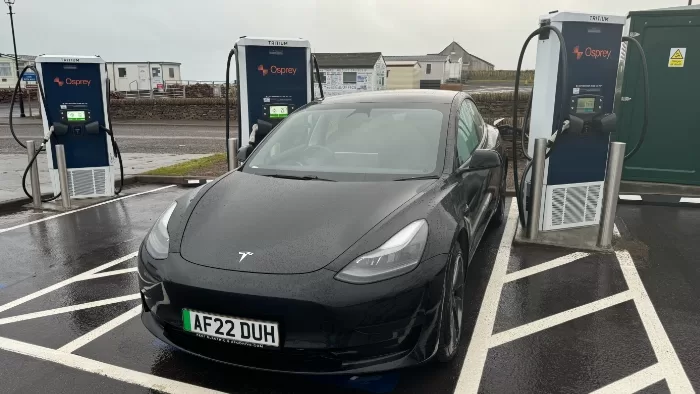
UFODrive promises contactless EV rental with all included charging thrown in – but what is it like to use? I took a UFODrive EV for a lengthy road trip review around the UK to find out.
| Pros | Cons |
|---|---|
| Genuinely contactless | Trickier if the right car isn’t actually there at pickup |
| All EV charging costs included | Dynamic pricing and distance limits makes it hard to compare total rental costings |
| Variety of available EV models | App unlocking and EV charger finding isn’t always great |
Score: 3.6/5
I recently took a lengthy holiday through the UK with my family – something we were planning do in late 2020, and I probably don’t have to tell you why that didn’t happen at that time.
Most of this trip was focused around catching up with family members and friends spread from London all the way up to Inverness, so the logistics of family travel – 4 adults and one adult-sized teenager – were not insubstantial.
Some of the places we wanted to visit were not airport-adjacent, and while I love a nice train trip, the economics of the UK rail system are, frankly, punitive.
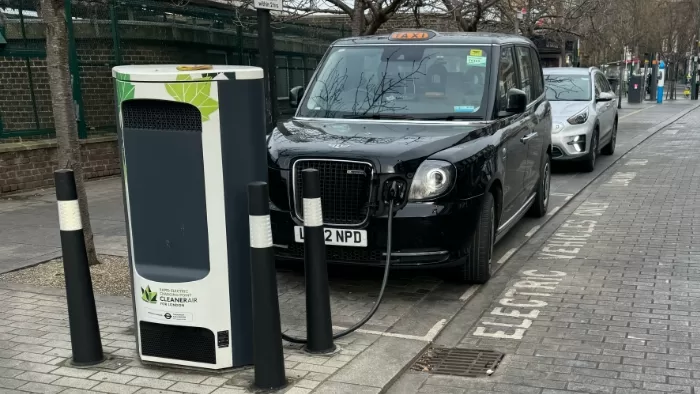
Car hire was going to be the way to manage this. Having switched to an entirely EV-based setup at home, I was keen to continue that journey, especially as (if you read the reports) the UK is considerably more advanced along the path of EV charger rollout than Australia is.
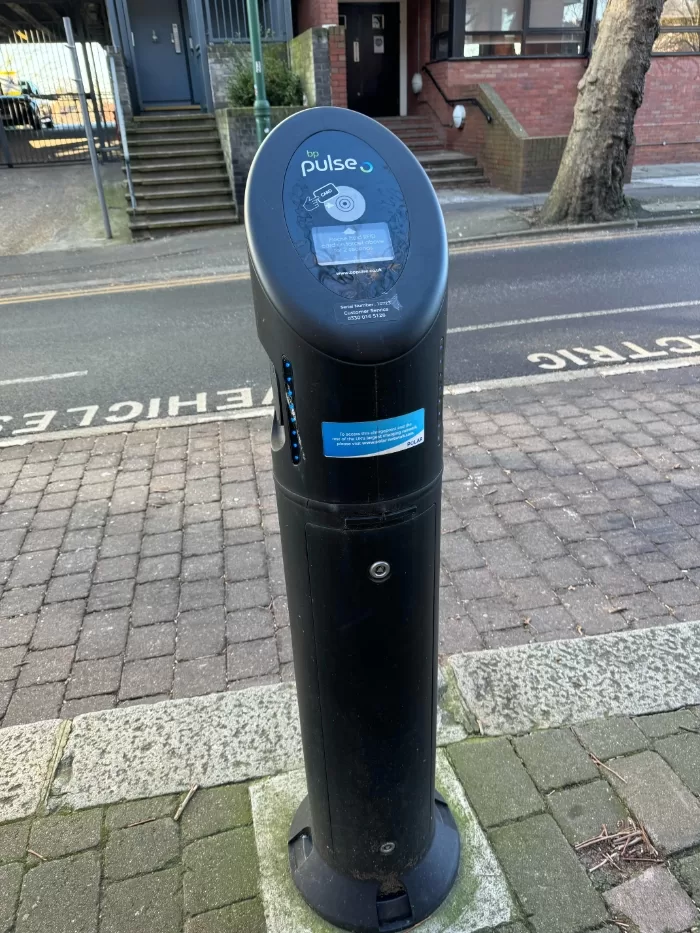
There are a number of your regular car hire places that have EVs as options, but my eye was caught by UFODrive, a company that sells itself on the prospect of contactless app-driven rentals for EVs only.
While I have had some genuinely good experiences with car hire staff over the years, it’s always the bad apples that stand out – and I’ve had some shockers, so the concept (as it’s pitched) of a car that I could drive away in a couple of minutes had a lot of appeal.
But what would the reality be like? There’s no way for me to write this up without it being lengthy, so strap in, dear reader.
Lots of detail to cover off, but I feel like that’s useful detail if you’re pondering using UFODrive for your next rental.
It’s worth noting that while the company has European, UK and US operations, there’s no sign of it launching in Australia as yet – and it’s not hard to see why.
UFODrive Signup
UFODrive’s pitch is that it’s entirely app-driven, but like any other car hire service, you still have to provide details before you can rent a vehicle, which involves setting up a profile in the UFODrive app (available for iPhone or Android).
This involves taking photos within the app of documents relating to your identity and suitability to drive, including your driver’s licence.
There’s an obvious point of concern here, because you’re entrusting documents that could be used for identity fraud to an app and an overseas company.
I did what research I could here, noting that (for example) while UFODrive is a relatively new company, starting up in 2018, it counts amongst its investors Hertz, so it does have some solid backing there. As always, proceed carefully.
The signup process is a little quirky, mostly because the app wants photos taken within the app – fair enough to avoid fraud via doctored photos – but it takes those shots very quickly indeed. I had a few instances where I had to take a snap again simply because it fired up too quickly.
It also took a few days to get every aspect of my login sorted, but I suspect that’s because I’m probably one of only a few – or maybe the first – drivers with a NSW driver’s licence using the service.
While AI is used for basic document identification purposes, there’s little doubting that there’s a touch of human live checking going on here too, based on my interactions with UFODrive’s support staff.
Booking itself is quite simple; you choose your dates and pickup location, which in my case was at Stratford International Car Park in East London, and you’re presented with a price.
I’d love to present a table of comparative pricing here, but I can’t… at all. The price I was paying at the time I was booking was comparably fair against rates for EVs I was seeing at the time.
But UFODrive uses a dynamic pricing model based on demand – very Uber, basically – at that does mean that pricing can go up quite a lot.
On my return, I queried about adding just a few hours to my drop-off time for my own convenience, and while I was willing to pay a price for those hours, the quoted price was more than two day’s rental cost based on the original rental term.
Not surprisingly, I declined, but it was informative around pricing. I guess many car hire places with onboard staff might not be that different – they’ll always sting you for more if you’re desperate – but the takeaway here is to do your sums carefully, especially as it relates to expected driving distance.

That’s because the other hook of UFODrive is that all EV charging costs are covered in the rental agreement, limited by a quantity of travel distance.
Basically you end up with an estimated mileage that you pay for upfront, and can adjust according to your expected needs. If you use less than 50% of your paid distance, you do get some level of refund, but if you go over, you pay a per-mile penalty.
In my case it was set to be 30p per mile, with 1900 miles pre-selected; as a reminder I was going to be travelling up to Scotland and back over a more than three week period.
I did actually go over that – thanks to a few day trips to places such Dundee, amongst others – though oddly UFODrive didn’t actually charge me anything for those excess miles.
At a guess there’s a small overage tolerance, though I was expecting to pay about 30 pounds for the overage.
I wouldn’t count on it, but I’m certainly happier to not have had to pay that smaller excess sum.
UFODrive: Collecting and returning the car
I booked seriously in advance, so had some months to wait for my actual rental day to happen.
That morning, UFODrive got in touch with me to indicate a problem. Alongside the actual rental fee, they also take a 500 pound bond against the car, and that hadn’t gone through correctly, most likely because I use a debit, not credit card.
The same card worked fine for paying for the rental some months prior, but on the day it wasn’t playing nice for a while.
I started to sweat it, being fully aware that the odds of getting the right sized vehicle (even an ICE vehicle) two days before Christmas in one of the biggest cities on Earth wasn’t likely to be an easy process if it all fell apart.
Some back and forth discussions with UFODrive staff through the app saw this sorted, but I highlight it because if it can happen to me, it can happen to you – and you do need to make sure that adequate funds are available at that time, too.
It was then time to walk over to the carpark; I was staying in Stratford (I’m familiar with the area) so this was a cold but simple enough step. UFODrive shares space in a public carpark with SIXT (which has a larger presence there), and I quickly found the UFODrive designated bays.
Two problems: There was a somewhat broken down ICE vehicle in one of the bays, and the licence plate to match to the car that was meant to be there was nowhere to be seen.
Back to the app and UFODrive’s support people! To their credit, they quickly pivoted and assigned me one of the other model 3 vehicles that was there, most of which had similar (but not identical) licence plates. A stolen EV, or a transposed licence plate in their systems? I’ll never know.
Those hurdles jumped, the actual rental process was very simple; take photos of all sides of the car (noting in any issues; the car I had was lightly scratched in a few places, but not “bad” in that sense), agree to a contract and it’s assigned to you so you can unlock it, start the car and start driving. Sans debit card and missing car issues, I genuinely could have driven away in under two minutes here, which is a big plus.
Jumping ahead a bit – because it feels like it’s part of the same process – the return process only hit one real issue.
You don’t have to return the car fully charged, but you do have to return it to its original hire site. When I did so, all the UFODrive bays were full of UFODrive cars… and I only had about 10 minutes left on my rental.
Thankfully there was a single (and I really do mean single, I circled the entire carpark multiple times) available public park, so I parked there and checked with UFODrive staff as to what to do.
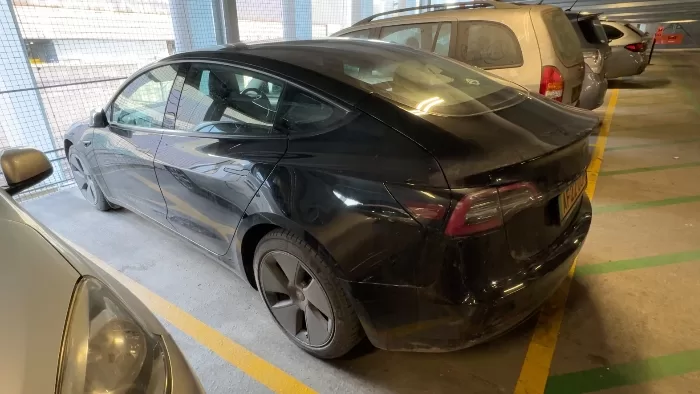
They were fine with it being in the same carpark, but I do wonder what the advice might have been if there had been no car parking at all available that day! It’s a weakness of a model with no onboard staff, I guess.
UFODrive: Charging and Driving in the UK
The UFODrive app is how you lock and unlock your rented vehicle, as well as starting it up and monitoring its power levels. It’s not to the same level as the Tesla app itself if you’re a regular Tesla driver, though it will give you indicative power levels if you head away from the car while it’s charging.
It did take me a little while of getting used to “locking” the Model 3 manually having become used to just walking away from my own version of the same car.
Slightly more problematically, the Bluetooth connection that the UFODrive app uses doesn’t always match to the car first time, meaning that often I had to refresh the app and try again if it didn’t want to play nice. Not a huge chore, but not a lot of fun when it’s minus four degrees and you just want to get inside the car!
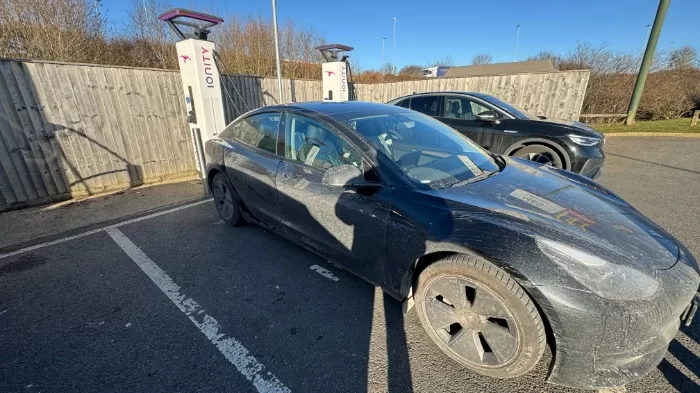
The actual car I got was instantly familiar to me, because it was a Model 3 of about the same generation as my own. It was pretty clearly a rental vehicle, which is to say that there were a few rough edges where other drivers may have been less gentle with it; the indicator stalks were a little twitchier than my own, for example.
It’s also worth noting that UFODrive absolutely locks the glovebox, leaving you with just the mid-console storage bays for your own stuff. I presume that’s to keep the onboard dashcam storage safe and secure in case of any accidents.
I will note that the specific car I had was not updated with the latest Tesla software updates. I held off on this for a while, not wanting to risk whatever setup UFODrive has in place for rentals locking me out. Checking via the App, I was told I could do so, but I didn’t have to, because they’d make sure it was done when the car was returned.
On reflection (while I shouldn’t have to use my own data to do so) I wish I had, simply because every once in a while on the road the car “lost” its map position and speed limits.
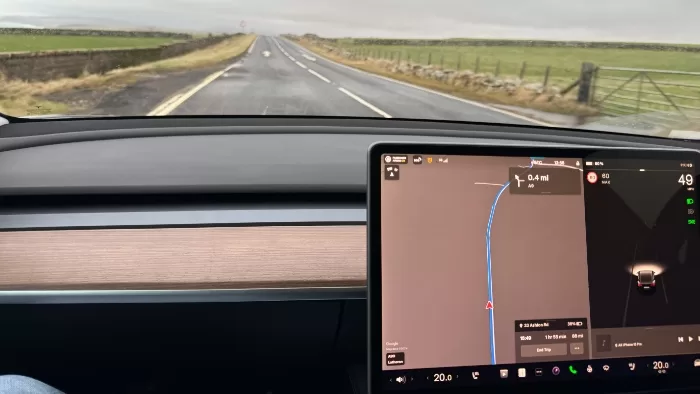
The UK road speed setup is a little different to Australia, where we put actual speed limit numbers on everything, so having the car note this is useful — and very stressful when it’s suddenly not available!
One amusing aspect of my experience was getting emails – just two of them – reminding me that the car was under 30% charge.
I guess that’s a good thing for new EV drivers who might be tempted to run to flat, but the realities of my own driving meant that it went under 30% more than just those two times, but I was only notified twice… and not at all the one time I did genuinely have a bit of a stretch drive that saw me roll into charging site with just 3% battery left.
It’s all but impossible to separate the experience of driving a rental EV and the broader layout of EV charging infrastructure in the UK… and I’m not going to even try.
The reality here is that while the UK is considerably further along the path of EV adoption and charging infrastructure than Australia is, with multiple charging sites in most towns, many supermarkets and plenty of out-of-the-way places, that’s not the same thing as saying it’s an entirely solved problem.
The model 3 I’d hired was of course only interested in sending me to Tesla superchargers. In Australia, by and large my experience with those (written about here, for example) has been largely positive.
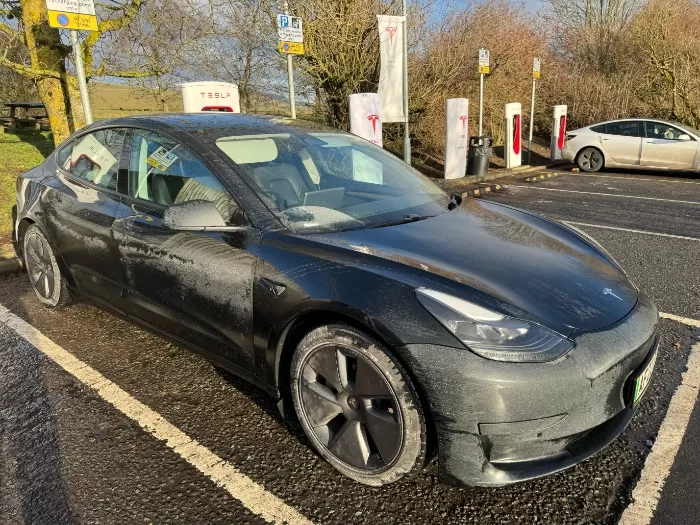
In the UK, it was considerably more mixed. There’s certainly a lot more of them to be sure, and plenty more coming along the way. As an example on the way back out of Scotland, I stopped at the Tesla Superchargers in Gretna Green. There’s four there – and I was lucky to get one without having to queue – but another eight were being built out while I was waiting, along with about a half-dozen or so alternative charger choices.
However, this wasn’t always the case, for a variety of reasons. One thing you hear about EVs a lot is that the battery range drops in cold temperatures – and that’s true – but so too it seems does charger efficiencies.
I spent considerable time in Inverness, site of Tesla’s northernmost UK charger. It’s theoretically 150kW capable, but I never got anywhere near that, and by a wide margin, even if there were no other cars there charging.
Yes, I know, you do get variable rates depending on the temperature of your battery and its charge level, but this was always more in the range of 22kW-50kW at best… and often slower.
I could swing that to my advantage by doing a little shopping or checking out the excellent Inverness Museum, but if I was on a longer road trip, it would be an annoying issue to have to deal with.
Then there was Adderstone, which promises 6 superchargers at up to 250kW.
That absolutely wasn’t the case when I went through, with just two operational chargers offering 22kW at best, one maybe sputtering up to 7kW, and three non-operational – including one that was bent downwards at a 45 degree angle that had clearly been hit by a truck or similar.
Adderstone is near precisely nothing, so that has to have been a deliberate act. I wish I’d taken a photo on reflection, but it was raining and this was a longer travel day, so I didn’t.
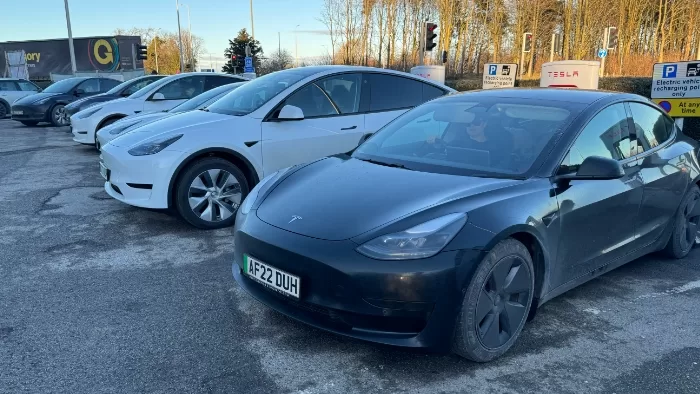
However, there are plenty of alternative charger networks in the UK that I could use, with the promise of charging cards to cover most of them, and refunds on any other charging fees I incurred.
The UFODrive app will even point out the compatible chargers in your immediate vicinity so you can find them… or at least, the ones it knows about.
There are two problems here. Firstly, it misses a lot of chargers, including those that worked just fine with the charging card supplied with the vehicle. It would be wise to grab Plugshare, ZapMap and ABRP on your smartphone to get a wider picture.
Second problem is that sometimes its choices are downright weird. On the second-last day of the rental, I was heading back down south to return the car, stopping in at Peterborough to stay with relatives.
I knew I needed a little more power, and not wanting to play around with whether the card would work or it wouldn’t, I decided to use the UFODrive app’s recommendations.
The closest charger wasn’t that far away, and I dropped the destination address into the car’s GPS… only to discover it was on an industrial estate that incorporated some massive Amazon warehouses and similar, a lot of security cameras and high chain link fences, and no obvious chargers at all!
Annoyed, I went for the second-best, which was a set of chargers at a motorway services station some distance away. That did work, albeit that I used the Ionity chargers at the location (not listed in the app) rather than the Gridserve ones that were – because they were already in use.
It would be much better if the UFODrive app listed all compatible chargers, and ideally if it made it easier to plan trips around available and compatible chargers… which brings me to another issue.
This one isn’t 100% UFODrive’s fault, but I’ll throw it in here as a cautionary matter for Australians (or other overseas travellers). The charging card that UFODrive supplied is said to work with around 85-90% of UK chargers… but there’s a big gap in that equation. A big, Scotland-sized gap, to be precise.
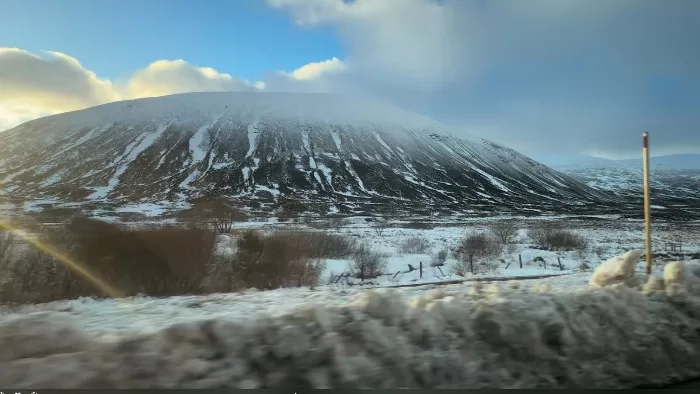
It’s not that Scotland lacks in chargers; there’s an entirely Scots-centric charger network — ChargePlace Scotland – with availability across all of that excellent country.
The problem here is that ChargePlace Scotland doesn’t work off third-party RFID cards; you need a ChargePlace Scotland account and fob, which needs a UK bank account or a virtual UK bank account to have been set up beforehand.
I didn’t have that (or the right amount of time onsite to make it happen), and all UFODrive could say was that they didn’t currently have deals in place with Scottish charger providers.
For a little while, it seemed that my dreams of going much further north than Inverness with its slow-but-existent Tesla chargers might be scuppered.
However, I persevered and researched, noting that outside of ChargePlace Scotland, there were limited Gridserve and Osprey chargers at John O’Groats (though some reviews noted that they were often out of order), as well as a Podpoint charger at the Tesco in nearby Wick.
Podpoint is slower and requires pre-payment, so I experimentally tested at a Tesco location in Inverness before setting off, just to see if it would work. It did, and to its credit, UFODrive fully reimbursed me for that smaller charging cost, because the charging card doesn’t cover Podpoint.
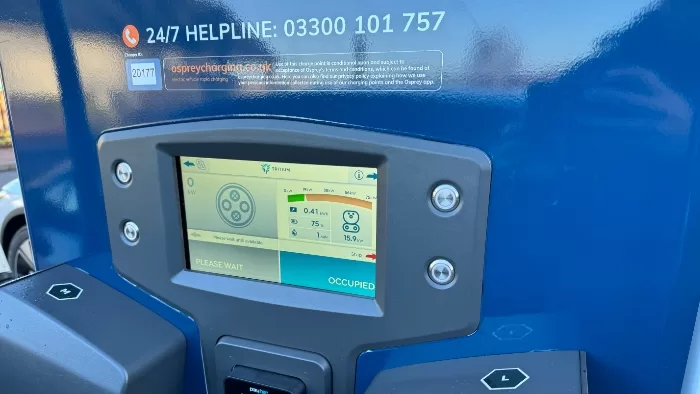
Side comment for Australian readers: If you want to complain about EV charging costs rising, spare a thought for UK drivers, where prices tend to range from 70-90p/kWh. Or in other words, at least double or more what we’re paying even at pricier chargers. But I digress…
Did I make it?
Yep. Couldn’t have filmed that without it.

The Osprey charger at John O’Groats worked like a charm, even in the extreme cold that day, and by the time I’d done the walk around in that video above, it had gone from around 20% up to 80% without issue.
The lesson to learn here is that it’s well worth doing your research beforehand. The ChargePlace Scotland issue might not be one that much longer; as I read it UK laws are mandating full contactless for all EV charging by the end of 2024 or thereabouts, though it’s always possible the slightly different laws in Scotland (the politics are interesting, but not within the scope of this review) might mean that takes a little longer.
Was this review useful to you? Consider supporting independent media by dropping a dollar or two in the tip jar below!
UFODrive: Alex’s Verdict
Was UFODrive as absolutely simple as its hype suggests? Not quite, though I can’t blame it for the state of UK charging infrastructure.
I’m happy enough with the rental price I paid, though the way it’s structured around “available” miles did give me pause for thought in the way I drove the car. In some ways, I might have been happier with a markedly lower price and charging myself with unlimited mileage, because I wouldn’t have had that point of stress.
Having competition with the established big players (even if Hertz is a heavy investor) is always a good thing. I suspect the relatively immature state of Australian EV sales and charging infrastructure, plus the sheer scale of the country would mean that this kind of approach wouldn’t work all that well here, however.
